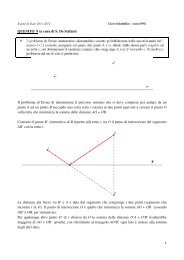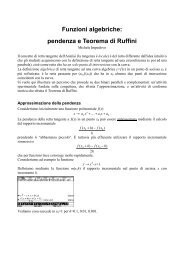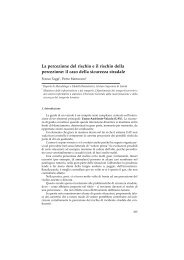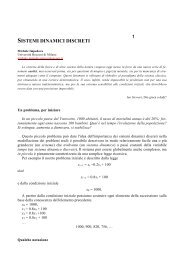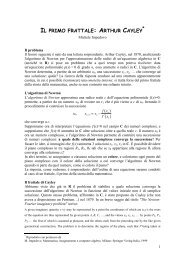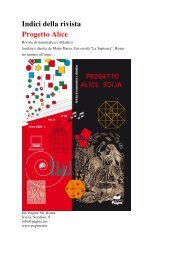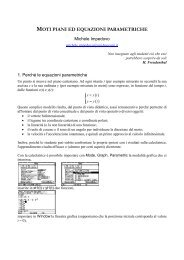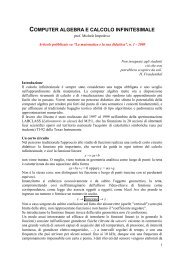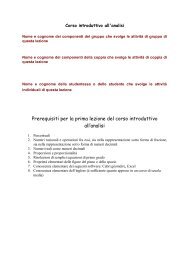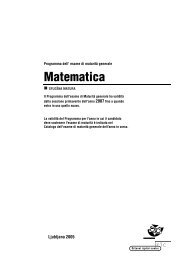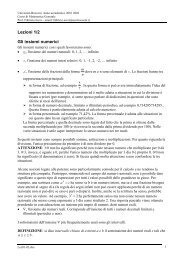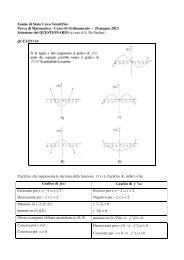metaphors in teaching and learning mathematics - Matematica
metaphors in teaching and learning mathematics - Matematica
metaphors in teaching and learning mathematics - Matematica
Create successful ePaper yourself
Turn your PDF publications into a flip-book with our unique Google optimized e-Paper software.
METAPHORS IN TEACHING AND LEARNING MATHEMATICS:<br />
A CASE STUDY CONCERNING INEQUALITIES<br />
Paolo BOERO, Luciana BAZZINI, Rossella GARUTI<br />
Dipartimento di <strong>Matematica</strong> Dipartimento di <strong>Matematica</strong> IRRSAE Emilia-Romagna<br />
Università di Genova Università di Pavia NRD Università di Genova<br />
ABSTRACT: In this paper an embodied cognition perspective is considered <strong>in</strong><br />
order to frame teach<strong>in</strong>g <strong>and</strong> learn<strong>in</strong>g problems concern<strong>in</strong>g <strong>in</strong>equalities. The nature<br />
<strong>and</strong> functions of some "ground<strong>in</strong>g <strong>metaphors</strong>" are discussed, as well as the<br />
possibility of enhanc<strong>in</strong>g their use by students.<br />
1. Introduction<br />
S<strong>in</strong>ce the beg<strong>in</strong>n<strong>in</strong>g of the eighties <strong>metaphors</strong> have been reconsidered as crucial<br />
components of th<strong>in</strong>k<strong>in</strong>g (see Lakoff <strong>and</strong> Johnson, 1980). The relevance of bodyrelated<br />
<strong>metaphors</strong> <strong>in</strong> mathematical th<strong>in</strong>k<strong>in</strong>g has been clearly stated by Lakoff <strong>and</strong><br />
Nunez (1997) <strong>and</strong> Nunez et al (1999) with some examples concern<strong>in</strong>g, <strong>in</strong> particular,<br />
natural numbers <strong>and</strong> cont<strong>in</strong>uity.<br />
Nunez (2000) describes conceptual <strong>metaphors</strong> as follows: "It is important to<br />
keep <strong>in</strong> m<strong>in</strong>d that conceptual <strong>metaphors</strong> are not mere figures of speech, <strong>and</strong> that<br />
they are not just pedagogical tools used to illustrate some educational material.<br />
Conceptual <strong>metaphors</strong> are <strong>in</strong> fact fundamental cognitive mechanisms (technically,<br />
they are <strong>in</strong>ference-preserv<strong>in</strong>g cross-doma<strong>in</strong> mapp<strong>in</strong>gs) which project the <strong>in</strong>ferential<br />
structure of a source doma<strong>in</strong> onto a target doma<strong>in</strong>, allow<strong>in</strong>g the use of effortless<br />
species-specific body-based <strong>in</strong>ference to structure abstract <strong>in</strong>ference". Consider<strong>in</strong>g<br />
conceptual <strong>metaphors</strong>, Lakoff <strong>and</strong> Nunez (2000) (see also Nunez, 2000) make a<br />
dist<strong>in</strong>ction between ground<strong>in</strong>g <strong>metaphors</strong> (i. e. conceptual <strong>metaphors</strong> which<br />
"ground our underst<strong>and</strong><strong>in</strong>g of mathematical ideas <strong>in</strong> terms of everyday experience")<br />
<strong>and</strong> other k<strong>in</strong>ds of conceptual <strong>metaphors</strong> (Redef<strong>in</strong>itional <strong>metaphors</strong>, L<strong>in</strong>k<strong>in</strong>g<br />
<strong>metaphors</strong>).<br />
This paper has three aims:<br />
- to show how different k<strong>in</strong>ds of ground<strong>in</strong>g <strong>metaphors</strong> can <strong>in</strong>tervene (as crucial<br />
tools of th<strong>in</strong>k<strong>in</strong>g) <strong>in</strong> novices' approach to <strong>in</strong>equalities;<br />
- to discuss possible ref<strong>in</strong>ements of the idea of a ground<strong>in</strong>g metaphor deriv<strong>in</strong>g<br />
from the analysis of students' behaviour <strong>and</strong> related to the cultural variety of possible<br />
everyday life source doma<strong>in</strong>s;<br />
- to <strong>in</strong>vestigate how ground<strong>in</strong>g <strong>metaphors</strong> can become a legitimate tool of<br />
th<strong>in</strong>k<strong>in</strong>g for students.<br />
In order to fulfil these aims, we will consider a teach<strong>in</strong>g experiment performed <strong>in</strong><br />
two VIII-grade classes (13-14 years old students) with the ma<strong>in</strong> purpose of detect<strong>in</strong>g
the young students' potential <strong>in</strong> deal<strong>in</strong>g with <strong>in</strong>equalities approached <strong>in</strong> a functional<br />
way (i.e. by consider<strong>in</strong>g them as comparisons of functions) . We will consider also<br />
four Ph. D. students' behaviour <strong>in</strong> similar tasks.<br />
2. Ground<strong>in</strong>g Metaphors <strong>and</strong> Communication Metaphors<br />
In <strong>mathematics</strong> as well as <strong>in</strong> other doma<strong>in</strong>s, many <strong>metaphors</strong> are frequently used<br />
with pure communication purposes: we will call them communication <strong>metaphors</strong>.<br />
For <strong>in</strong>stance, <strong>in</strong> a sentence like "The proof of this theorem was like an obstacle race:<br />
once some progress was made, immediately another difficulty appeared" the<br />
obstacle race metaphor fulfils a pure communication purpose which has no<br />
mathematical content. Communication <strong>metaphors</strong> can also be employed <strong>in</strong> order to<br />
substitute for technical espressions which are not shared by the <strong>in</strong>terlocutor: this<br />
happens frequently <strong>in</strong> a popularisation situation.<br />
Can <strong>metaphors</strong> fulfil other functions, <strong>in</strong> particular th<strong>in</strong>k<strong>in</strong>g tool functions<br />
The examples produced <strong>in</strong> recent papers by Lakoff <strong>and</strong> Nunez (1997; 2000),<br />
Nunez, Edwards <strong>and</strong> Matos (1999) <strong>and</strong> Nunez (2000) show how some <strong>metaphors</strong><br />
(conceptual <strong>metaphors</strong>) can function as th<strong>in</strong>k<strong>in</strong>g tools, <strong>in</strong> particular as ways of<br />
th<strong>in</strong>k<strong>in</strong>g about peculiar mathematical objects; these authors go further <strong>in</strong><br />
hypothesiz<strong>in</strong>g that conceptual <strong>metaphors</strong> (<strong>in</strong> particular, ground<strong>in</strong>g <strong>metaphors</strong> - i.e.<br />
those referr<strong>in</strong>g to everyday body actions <strong>and</strong> relations) are not exceptions, but usual<br />
ways of th<strong>in</strong>k<strong>in</strong>g <strong>in</strong> <strong>mathematics</strong>.<br />
The dist<strong>in</strong>ction between communication <strong>metaphors</strong> <strong>and</strong> ground<strong>in</strong>g <strong>metaphors</strong>,<br />
<strong>and</strong> the very existence of ground<strong>in</strong>g <strong>metaphors</strong> <strong>in</strong> a given <strong>mathematics</strong> doma<strong>in</strong>, are<br />
relevant for educational purposes: <strong>in</strong>deed communication <strong>metaphors</strong> could not solve<br />
deep learn<strong>in</strong>g problems <strong>and</strong> so they would dem<strong>and</strong> weak engagement by teachers.<br />
On the contrary, teachers should legitimate <strong>and</strong> enhance the use of ground<strong>in</strong>g<br />
<strong>metaphors</strong> as tools of th<strong>in</strong>k<strong>in</strong>g. Special attention should be paid to the existence <strong>and</strong><br />
functions of ground<strong>in</strong>g <strong>metaphors</strong> <strong>in</strong> those <strong>mathematics</strong> doma<strong>in</strong>s where difficulties<br />
of learn<strong>in</strong>g are greater: <strong>in</strong>deed ignor<strong>in</strong>g specific ground<strong>in</strong>g <strong>metaphors</strong> could be one<br />
of the reasons for students' difficulties (see the analysis of the difficulties <strong>in</strong>herent <strong>in</strong><br />
the learn<strong>in</strong>g of cont<strong>in</strong>uity, <strong>in</strong> Nunez, Edwards <strong>and</strong> Matos, 1999).<br />
In this paper we deal with ground<strong>in</strong>g <strong>metaphors</strong> <strong>in</strong> the doma<strong>in</strong> of <strong>in</strong>equalities; as<br />
we will see <strong>in</strong> the next section, for different reasons (<strong>in</strong>clud<strong>in</strong>g students' difficulties)<br />
this subject is poorly covered <strong>in</strong> current teach<strong>in</strong>g. The challenge com<strong>in</strong>g from an<br />
embodied cognition perspective (Lakoff <strong>and</strong> Nunez, 1997; Nunez, 2000) is to<br />
ascerta<strong>in</strong> at what extent ground<strong>in</strong>g <strong>metaphors</strong> can support the teach<strong>in</strong>g <strong>and</strong> learn<strong>in</strong>g<br />
of this subject <strong>and</strong> overcome some of the students' difficulties.<br />
Another problem concerns the necessity of establish<strong>in</strong>g whether novices'<br />
ground<strong>in</strong>g <strong>metaphors</strong> do substitute more advanced th<strong>in</strong>k<strong>in</strong>g tools; <strong>in</strong> this case their<br />
importance should be only temporary <strong>in</strong> the students' career. For this reason <strong>in</strong> our<br />
experimental study we considered both novices (VIII-graders) <strong>and</strong> university
students (<strong>in</strong> particular, four Ph.D. students <strong>in</strong> <strong>mathematics</strong>) engaged <strong>in</strong> structurally<br />
similar tasks (even if the level of difficulty was different: see Annexes).<br />
3. Rationale of the Experimental Study<br />
In spite of their importance <strong>in</strong> pure <strong>and</strong> applied <strong>mathematics</strong>, <strong>in</strong>equalities<br />
constitute a neglected <strong>and</strong> ill-treated subject <strong>in</strong> secondary school curricula. In most<br />
countries, <strong>in</strong>equalities are taught as a subord<strong>in</strong>ate subject (<strong>in</strong> relationship with<br />
equations), dealt with <strong>in</strong> purely algorithmic manner which avoids, <strong>in</strong> particular, the<br />
difficulties <strong>in</strong>herent <strong>in</strong> the concept of function (see Assude, 2000; Sackur <strong>and</strong><br />
Maurel, 2000). As a consequence, students are unable to manage <strong>in</strong>equalities which<br />
do not fit the learned schemas. For <strong>in</strong>stance, accord<strong>in</strong>g to different <strong>in</strong>dependent<br />
studies (cfr. Boero, 2000; Malara, 2000) at the entrance of the university<br />
<strong>mathematics</strong> courses <strong>in</strong> Italy most students fail to solve easy non st<strong>and</strong>ard<br />
<strong>in</strong>equalities like x 2 - 1/x > 0.<br />
Concern<strong>in</strong>g the mathematical relevance of the current teach<strong>in</strong>g of <strong>in</strong>equalities <strong>in</strong><br />
school, we may observe that it does not take <strong>in</strong>to account the importance of<br />
<strong>in</strong>equalities <strong>in</strong> pure <strong>and</strong> applied <strong>mathematics</strong> (for <strong>in</strong>stance <strong>in</strong> the case of the concept<br />
of limit or to deal with asymptotic stability) <strong>and</strong> the fact that <strong>in</strong> many cases equations<br />
are solved with approximation methods which are based on <strong>in</strong>equalities (thus<br />
revers<strong>in</strong>g the usual approach to <strong>in</strong>equalities <strong>in</strong> school - as a subject subord<strong>in</strong>ate to<br />
equations).<br />
This brief presentation br<strong>in</strong>gs to the follow<strong>in</strong>g conclusion: the prevail<strong>in</strong>g manner<br />
of teach<strong>in</strong>g <strong>in</strong>equalities <strong>in</strong> school neither is efficient (as concerns the results, <strong>in</strong><br />
terms of the capacity to deal with a large set of rather simple but non st<strong>and</strong>ard<br />
<strong>in</strong>equalities) nor fits relevant aspects of the professional (mathematicians') practice<br />
about <strong>in</strong>equalities. In order to try to f<strong>in</strong>d the reasons of this situation <strong>and</strong> elaborate<br />
tools for overcom<strong>in</strong>g it, we can observe that the functional aspect plays a crucial role<br />
<strong>in</strong> mathematicians' work, both for equations <strong>and</strong> <strong>in</strong>equalities. This fact is often<br />
neglected <strong>in</strong> traditional teach<strong>in</strong>g. From a functional po<strong>in</strong>t of view, <strong>in</strong>equalities fully<br />
<strong>in</strong>volve difficult concepts like variable <strong>and</strong> function <strong>in</strong> situations which need a<br />
complex treatment. As suggested at the beg<strong>in</strong>n<strong>in</strong>g of this section, we can recognize<br />
that the traditional teach<strong>in</strong>g of <strong>in</strong>equalities avoids the "function" concept <strong>and</strong><br />
reduces the difficulties <strong>in</strong>eherent <strong>in</strong> the variable concept <strong>and</strong> the complexity of the<br />
solution process by treat<strong>in</strong>g <strong>in</strong>equalities as a special case of equations.<br />
Keep<strong>in</strong>g <strong>in</strong> m<strong>in</strong>d this analysis, when plann<strong>in</strong>g the teach<strong>in</strong>g experiment with two<br />
VIII-grade classes our basic cultural choice consisted <strong>in</strong> treat<strong>in</strong>g equations <strong>and</strong><br />
<strong>in</strong>equalities from a functional po<strong>in</strong>t of view, i.e. approach<strong>in</strong>g them as special cases<br />
of comparison of functions.<br />
Here some details about the classes, educational choices <strong>and</strong> classroom activities<br />
are reported:
- 36 VIII-grade students (divided <strong>in</strong>to two classes) were <strong>in</strong>volved; as usual <strong>in</strong><br />
Italy, they had started to work with the same <strong>mathematics</strong> <strong>and</strong> science teacher <strong>in</strong><br />
grade VI;<br />
- the didactic contract established <strong>in</strong> grades VI, VII <strong>and</strong> at the beg<strong>in</strong>n<strong>in</strong>g of grade<br />
VIII was coherent with the methodological choice of a cooperative, participated,<br />
guided enrichment of tools <strong>and</strong> skills <strong>in</strong> the planned activity. A rather common<br />
rout<strong>in</strong>e of classroom work consisted <strong>in</strong> <strong>in</strong>dividual production of written solutions for<br />
a given task (if necessary, supported by the teacher with 1-1 <strong>in</strong>terventions), followed<br />
by classroom comparison <strong>and</strong> discussion of students' products, guided by the teacher<br />
<strong>and</strong>, possibly, by the adoption of other students' solutions <strong>in</strong> similar tasks. Another<br />
aspect of the didactic contract <strong>in</strong>cluded the exhaustive written word<strong>in</strong>g of doubts,<br />
discoveries, heuristics, etc.;<br />
- the approach to the concept of function was built up through activities <strong>in</strong>volv<strong>in</strong>g<br />
tables, graphs <strong>and</strong> formulas <strong>and</strong> ma<strong>in</strong>ly concern<strong>in</strong>g geometric entities (lengths,<br />
perimeters, areas, etc.). After some <strong>in</strong>itial activities on functions as mach<strong>in</strong>es<br />
(operational view) <strong>and</strong> then as x to y correspondences (correspondence view: see<br />
Slavit, 1997 for a survey about these different views), po<strong>in</strong>t-by-po<strong>in</strong>t draw<strong>in</strong>g of<br />
graphs was discouraged, while mak<strong>in</strong>g hypotheses about their shape (start<strong>in</strong>g from<br />
their formula) was greatly encouraged;<br />
- the role of the teacher was to help students through 1-1 <strong>in</strong>teractions <strong>and</strong> manage<br />
students' classroom discussions. In particular, students were encouraged to<br />
communicate their ideas with words, gestures, graphs drawn at the blackboard, etc..<br />
Collected materials from the two classes consisted <strong>in</strong> <strong>in</strong>dividual protocols, audiorecord<strong>in</strong>gs<br />
of classroom discussions <strong>and</strong> detailed teachers' notes. The same materials<br />
were collected <strong>in</strong> the case of the four Ph. D. students <strong>in</strong> Mathematics <strong>in</strong>volved <strong>in</strong> this<br />
study for comparison purposes (see end of Section 2).<br />
4. Ground<strong>in</strong>g Metaphors <strong>and</strong> Inequalities<br />
In the Annexe 1 some excerpts of a student's solution are reported; they are<br />
representative of a large set of protocols deriv<strong>in</strong>g from the written solutions of the<br />
36 VIII-grade students considered <strong>in</strong> this study. Also a solution from a Ph. D. is<br />
reported (Annexe 2), to show impressive similarities between the novices' strategies<br />
<strong>in</strong> deal<strong>in</strong>g with open problems concern<strong>in</strong>g <strong>in</strong>equalities <strong>and</strong> the efforts of an expert<br />
young mathematician <strong>in</strong> deal<strong>in</strong>g with a similar, more difficult task (<strong>in</strong> fact, a task not<br />
covered by learned procedures).<br />
Different <strong>metaphors</strong> surface <strong>in</strong> students' protocols. For space restrictions we will<br />
consider only one crucial step of the solution: the search for pivot po<strong>in</strong>ts around<br />
which the direction of the <strong>in</strong>equality changes. In many protocols we f<strong>in</strong>d one (or<br />
more) of the follow<strong>in</strong>g <strong>metaphors</strong>:<br />
- dynamical reference to <strong>in</strong>creas<strong>in</strong>g <strong>and</strong> decreas<strong>in</strong>g values, <strong>and</strong> the necessity of a<br />
meet<strong>in</strong>g po<strong>in</strong>t supported by consecutive dynamical gestures of one h<strong>and</strong> (firstly
<strong>in</strong>dicat<strong>in</strong>g <strong>in</strong>crease, then decrease, or vice-versa); words are coherent with this body<br />
dynamic representation: students speak about go<strong>in</strong>g up <strong>and</strong> go<strong>in</strong>g down of the two<br />
functions (formulas, graphs, etc.), <strong>and</strong> thus they must “meet <strong>in</strong> one po<strong>in</strong>t” (meet<strong>in</strong>g<br />
metaphor): "one graph goes up steeper <strong>and</strong> steeper from below <strong>and</strong> must meet the<br />
other which <strong>in</strong>creases <strong>and</strong> then goes down” (see Annexe 2).<br />
- reference to the imag<strong>in</strong>ed (or drawn) shapes of the two graphs, <strong>and</strong> the necessity<br />
of a meet<strong>in</strong>g po<strong>in</strong>t supported by static cross<strong>in</strong>g of the two arms; aga<strong>in</strong> words are<br />
coherent with this static body representation: the two graphs "must have one po<strong>in</strong>t <strong>in</strong><br />
common" (<strong>in</strong>tersection metaphor);<br />
- balance metaphor: <strong>in</strong> this case the idea of a possible equilibrium between the<br />
values of the two functions drives the student’s attention towards values of x which<br />
are near to satisfy the equation. A reference to physical trials performed <strong>in</strong> order to<br />
reach the equilibrium po<strong>in</strong>t is evident. We may note that the balance metaphor was<br />
used by students to guide the search for the equilibrium po<strong>in</strong>t <strong>in</strong> different ways: <strong>in</strong><br />
particular with numerical trials on the two sides <strong>in</strong> order to approach the equilibrium<br />
po<strong>in</strong>t; or through a regular movement from left to right (see Annexe 1 for an<br />
example).<br />
5. Discussion<br />
In our op<strong>in</strong>ion, the reported excerpts <strong>and</strong> the examples of the <strong>metaphors</strong><br />
surfac<strong>in</strong>g <strong>in</strong> VIII-grade students' attempts to f<strong>in</strong>d the 'pivot po<strong>in</strong>ts' (as well as <strong>in</strong> the<br />
Ph. D. students protocols: see Annexes) raise three relevant questions:<br />
Can we speak of ground<strong>in</strong>g <strong>metaphors</strong><br />
The communication function does not seem to be the most important function <strong>in</strong><br />
the students' protocols: <strong>metaphors</strong> “project the <strong>in</strong>ferential structure of a source<br />
doma<strong>in</strong> onto a target doma<strong>in</strong>” , accord<strong>in</strong>g to Nunez's description of conceptual<br />
<strong>metaphors</strong> (see Section 1), <strong>and</strong> the relationships established <strong>in</strong> the different source<br />
doma<strong>in</strong>s (for <strong>in</strong>stance: balance equilibrium) serve as crucial references to <strong>in</strong>fer<br />
conclusions <strong>in</strong> the target doma<strong>in</strong> (functions <strong>and</strong> <strong>in</strong>equalities). In particular, the<br />
necessity of a po<strong>in</strong>t belong<strong>in</strong>g to both graphs derives from the necessity that can be<br />
experienced <strong>in</strong> the source doma<strong>in</strong> (see later for a detailed analysis).<br />
Can we consider the ground<strong>in</strong>g <strong>metaphors</strong> used by students as spontaneous, or<br />
may we identify their orig<strong>in</strong> <strong>in</strong> classroom activities<br />
The knowledge of students' background br<strong>in</strong>gs to the hypothesis that words <strong>and</strong><br />
gestures (strongly encouraged by the teacher dur<strong>in</strong>g the previous classroom activities<br />
on functions: see Section 3) allowed different k<strong>in</strong>ds of ground<strong>in</strong>g <strong>metaphors</strong><br />
concern<strong>in</strong>g functions <strong>and</strong> variables to become legitimate <strong>and</strong> spread <strong>in</strong> the<br />
classroom. We would like to make some comments about legitimacy <strong>and</strong> spread<strong>in</strong>g.<br />
Legitimacy means that students were allowed to overtly reason through those k<strong>in</strong>ds<br />
of ground<strong>in</strong>g <strong>metaphors</strong>. This is not frequent <strong>in</strong> <strong>mathematics</strong> teach<strong>in</strong>g (even <strong>in</strong> lower<br />
grades): abstract reason<strong>in</strong>gs are privileged. Spread<strong>in</strong>g means that overt, legitimate
gestures <strong>and</strong> words were freely adopted by the schoolmates, accord<strong>in</strong>g to their<br />
personal needs; by this way different ground<strong>in</strong>g <strong>metaphors</strong> became accessible as<br />
th<strong>in</strong>k<strong>in</strong>g tools for deal<strong>in</strong>g with variables <strong>and</strong> functions. For <strong>in</strong>stance, the balance<br />
metaphor was produced by the author of the first protocol (Annexe 1) <strong>in</strong> a previous<br />
situation; the teacher promoted a discussion about it; then it spread <strong>in</strong> the classroom<br />
(9 students used it <strong>in</strong> the task reported <strong>in</strong> Annexe 1).<br />
If this perspective is appropriate to describe what happened <strong>in</strong> the two<br />
classrooms, the teacher's role seems to be crucial <strong>in</strong> order to provide students with<br />
the opportunity of access<strong>in</strong>g powerful ground<strong>in</strong>g <strong>metaphors</strong>. We can imag<strong>in</strong>e that<br />
potentially every student can use them; but this potential does not translate <strong>in</strong>to an<br />
effective, appropriate use if this use is not legitimate <strong>and</strong> supported by appropriate<br />
signs (particularly words <strong>and</strong> gestures). From the research po<strong>in</strong>t of view it would be<br />
<strong>in</strong>terest<strong>in</strong>g to better underst<strong>and</strong> the specific role of signs (words <strong>and</strong> gestures) <strong>in</strong> the<br />
appropriation (or activation) <strong>and</strong> function<strong>in</strong>g of the ground<strong>in</strong>g <strong>metaphors</strong><br />
considered.<br />
In the case of the search for pivot po<strong>in</strong>ts how can we dist<strong>in</strong>guish between the<br />
three k<strong>in</strong>ds of <strong>metaphors</strong> described above<br />
The very nature of the source doma<strong>in</strong>s show important differences between the<br />
different <strong>metaphors</strong>. All of them enter the def<strong>in</strong>ition of ground<strong>in</strong>g metaphor quoted<br />
<strong>in</strong> Section 1, but the nature of the evoked everyday experience is not the same <strong>in</strong> the<br />
different cases: aga<strong>in</strong> consider<strong>in</strong>g the three ground<strong>in</strong>g <strong>metaphors</strong> surfac<strong>in</strong>g <strong>in</strong> the<br />
research for the pivot po<strong>in</strong>ts, <strong>in</strong> the first case we can recognize a reference to an<br />
everyday experience concern<strong>in</strong>g cross<strong>in</strong>g of movements. It is <strong>in</strong>terest<strong>in</strong>g to observe<br />
that the gestures for the description of this situation are the same that we would use<br />
<strong>in</strong> describ<strong>in</strong>g the cross<strong>in</strong>g of two people climb<strong>in</strong>g <strong>and</strong> descend<strong>in</strong>g a staircase. A<br />
physical experience concern<strong>in</strong>g ord<strong>in</strong>ary life supports the necessity of a meet<strong>in</strong>g<br />
po<strong>in</strong>t. In the second case, a familiar situation of a necessary cross<strong>in</strong>g of two<br />
cont<strong>in</strong>uous l<strong>in</strong>es is evoked: the activity of draw<strong>in</strong>g l<strong>in</strong>es on plane surfaces provides<br />
the support for the visual necessity of a common po<strong>in</strong>t. In the third case, an everyday<br />
life technological situation is evoked: a technological tool (the balance) provides the<br />
physical necessity of an equilibrium po<strong>in</strong>t (<strong>in</strong> fact, the pivot po<strong>in</strong>t). These remarks<br />
suggest the consideration of different k<strong>in</strong>ds of everyday experience, with different<br />
relationships between culture <strong>and</strong> body: an immediate relationship <strong>in</strong> the first case, a<br />
visual culture-mediated relationship <strong>in</strong> the second case, a technology-mediated<br />
relationship <strong>in</strong> the third case. In other words, we could speak of different culturemediated<br />
necessities for a pivot po<strong>in</strong>t <strong>in</strong> the three cases.<br />
Even these remarks suggest some educational implications: a variety of everyday<br />
experiences should be recognized <strong>and</strong> encouraged by the teacher <strong>in</strong> the classroom as<br />
legitimate sources of ground<strong>in</strong>g <strong>metaphors</strong> for crucial <strong>mathematics</strong> concepts <strong>and</strong><br />
situations.<br />
References
Assude, T.: 2000, 'De l'usage de 'techniques faibles' et 'techniques fortes' dans l'organisation du<br />
curriculum', Actes des Sém<strong>in</strong>aires SFIDA-9 à SFIDA-12, Vol. III (IX), pp.9-14, IREM, Nice.<br />
Boero, P.: 2000, 'Inequations: aspects didactiques, épistémologiques et cognitifs', Actes des<br />
Sém<strong>in</strong>aires SFIDA-9 à SFIDA-12, Vol. III (X), pp. 3-6, IREM, Nice<br />
Lakoff, G. & Johnson, M.: 1980, Metaphors We Live By, University of Chicago Press, Chicago<br />
Lakoff, G. & Nunez, R.: 1997, 'The metaphorical structure of <strong>mathematics</strong>: Sketch<strong>in</strong>g out cognitive<br />
foundations for a m<strong>in</strong>d-based <strong>mathematics</strong>', <strong>in</strong> L. English (ed.), Mathematical Reason<strong>in</strong>g:<br />
Analogies, Metaphors <strong>and</strong> Cognition: Bridg<strong>in</strong>g the Gap, Erlbaum, Mahwah, NJ<br />
Lakoff, G. & Nunez, R.: 2000, Where Mathematics Comes From: How the Embodied M<strong>in</strong>d Br<strong>in</strong>gs<br />
Mathematics <strong>in</strong>to Be<strong>in</strong>g, Basic Books, New York<br />
Malara, N.: 2000, 'Una riflessione sui comportamenti di studenti universitari nello studio di<br />
disequazioni', Actes des Sém<strong>in</strong>aires SFIDA-9 à SFIDA-12,Vol.III (XII),pp 13-28, IREM, Nice.<br />
Nunez, R.; Edwards, L. & Matos, J.F.: 1999, 'Embodied cognition as ground<strong>in</strong>g for situatedness<br />
<strong>and</strong> context <strong>in</strong> <strong>mathematics</strong> education', Educational Studies <strong>in</strong> Mathematics, 39, 45-65.<br />
Nunez, R.: 2000, 'Mathematical Idea Analysis: What Embodied Cognitive Science Can Say about<br />
the Human Nature of Mathematics', Proceed<strong>in</strong>gs of PME-XXIV, Hiroshima, vol. I, pp. 3-21.<br />
Sackur, C. & Maurel, M.: 2000, 'Les outils théoriques du GECO et les <strong>in</strong>équations en classe de<br />
seconde', Actes des Sém<strong>in</strong>aires SFIDA-9 à SFIDA-12, Vol. III (X), pp. 7-24, IREM, Nice.<br />
Slavit, D.: 1997, 'An alternate route to the reification of functions', Educational Studies <strong>in</strong><br />
Mathematics, 33, 259-281<br />
Tsamir P., Almog N., Tirosh D.: 1998, Students’ solutions of <strong>in</strong>equalities, Proceed<strong>in</strong>gs of PME 22,<br />
Vol.4, pp. 129-136.<br />
Annexe 1: some excerpts from the first part of an VIII-grade student's solution to<br />
the follow<strong>in</strong>g problem:<br />
Compare the follow<strong>in</strong>g formulas from an algebraic <strong>and</strong> a graphical pont of view.<br />
Make hypotheses about their graphs <strong>and</strong> motivate them carefully, f<strong>in</strong>ally draw a<br />
sketch of their graphs. A) y= x 2 - 4x +4 B) y= -x 2 +4<br />
"Due to the fact that x 2 , that is x multiplied by itself, is there, we should get two<br />
parabolas. The presence of +4 makes them start from +4 when x=0<br />
The first curve will meet twice the second: at +4 (on the y axis) <strong>and</strong> <strong>in</strong> another<br />
po<strong>in</strong>t to be found. The first curve will go down, <strong>in</strong> the first quadrant, below 4 when<br />
the weight of 4x will be greater than x 2 <strong>and</strong> will go up aga<strong>in</strong> when this situation will<br />
be over.<br />
When does the first curve go below +4 Mov<strong>in</strong>g from 0 on the right, the first<br />
curve will go below +4 till when -4x will balance x 2 , that is they will become equal
The second parabola is a very usual parabola, but it is translated "upwards" by<br />
+4 <strong>and</strong> made negative as an effect of -x 2 which makes everyth<strong>in</strong>g negative. It will<br />
rema<strong>in</strong> over the level 0 for a while, until +4 will rema<strong>in</strong> greater than -x 2 . But when<br />
will x 2 equilibrate +4 (draw<strong>in</strong>g: aga<strong>in</strong> a schematic representation of a balance). When -x 2<br />
will give a number that will annihilate +4, that is -4. When -2 . 2+4=-4+4=0 [...]"<br />
Annexe 2: a Ph. D. student's solution for the follow<strong>in</strong>g problem: "To f<strong>in</strong>d where<br />
xs<strong>in</strong>x>x 2 -1". The student is <strong>in</strong>vited to tell aloud what he th<strong>in</strong>ks.<br />
(from audiorecord<strong>in</strong>g <strong>and</strong> notes taken by the <strong>in</strong>terviewer)<br />
"It is evident that the parabole overcomes the other function when x grows <strong>in</strong><br />
absolute value, because xs<strong>in</strong>x cannot be bigger than the absolute value of x. It is a<br />
parabole compared with two straight l<strong>in</strong>es outcom<strong>in</strong>g from the orig<strong>in</strong> <strong>and</strong> mov<strong>in</strong>g<br />
upwards (he makes gestures show<strong>in</strong>g the two curves, then he makes a sketch on paper). The<br />
problem is what happens near to zero. Indeed if x=0 I see that the parabole is below<br />
the other function. But... xs<strong>in</strong>x... it is a pair function, a symmetric function... Well, I<br />
can consider only the positive side of the x axis. Here I imag<strong>in</strong>e... x 2 -1 is like x 2<br />
lowered by one (gestures <strong>in</strong> the air: a parabole then a lower parabole). OK, the other function<br />
goes up <strong>and</strong> down, but def<strong>in</strong>itively it will rema<strong>in</strong> below the parabole... I have<br />
already said it (he po<strong>in</strong>ts to the draw<strong>in</strong>g). Now I must coord<strong>in</strong>ate what happens near to<br />
zero <strong>and</strong> what happens at large (he carefully draws the parabole y=x 2 -1, the y=-x <strong>and</strong> the y=x<br />
straight l<strong>in</strong>es). I must be more precise, <strong>and</strong> see where xs<strong>in</strong>x meets the x axis (he makes a<br />
sign for 1, 2,3,4, 5, 6, then he makes a sketch of the graph of xs<strong>in</strong>x for x>0, say<strong>in</strong>g: "it goes up<br />
<strong>and</strong> down between these two straight l<strong>in</strong>es"). It looks f<strong>in</strong>e. Oh, oh, this sketch is not<br />
precise enough - I must f<strong>in</strong>d where xs<strong>in</strong>x meets x... OK, s<strong>in</strong>x=1, it is here (he makes<br />
a sign on the straight l<strong>in</strong>e by go<strong>in</strong>g up from the value of approx. 1.5 on the x axis,<br />
then he draws a more precise graph of y=xs<strong>in</strong>x between 0 <strong>and</strong> 3). xs<strong>in</strong>x=x 2 -1 ... no<br />
precise solution, but a solution do exist, I see here, one graph goes up steeper <strong>and</strong><br />
steeper from below <strong>and</strong> must meet the other which <strong>in</strong>creases <strong>and</strong> then goes down.<br />
But I should get no more than one solution... Let us see: if x=1.5, x 2 -1 makes 2.25-1,<br />
that is 1.25... bigger than one, but not so bigger... It means that the meet<strong>in</strong>g po<strong>in</strong>t is<br />
near to 1.5 on the left... OK, my draw<strong>in</strong>g was OK! I can see that x 2 -1 overcomes<br />
xs<strong>in</strong>x out of this <strong>in</strong>terval (he rapidly completes the draw<strong>in</strong>g by symmetry on the left, <strong>and</strong> makes
symmetric gestures with the two h<strong>and</strong>s to <strong>in</strong>dicate the two symmetric parts of the x axis, out of the<br />
central <strong>in</strong>terval)".



